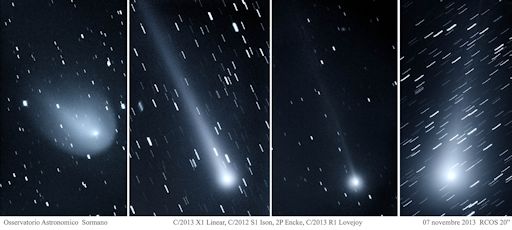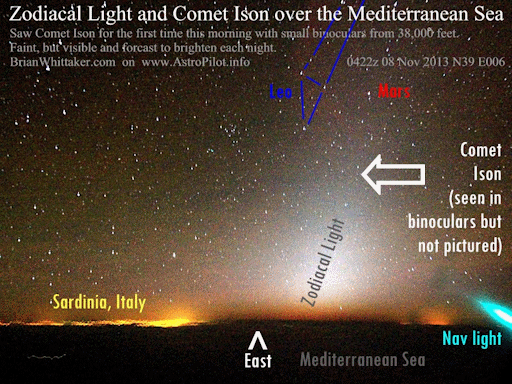From Sheldon Day...
DISTANCE FROM SUN: 70,889,000 MILES
COMET ISON NOW A BINOCULAR OBJECT: Comet ISON is brightening as it approaches the sun. Multiple observers now report that it is a binocular object. "I finally saw Comet ISON for the first time using small binoculars!" says pilot Brian Whittaker. He was flying 38,000 feet over the Mediterranean Sea on Nov. 8th when he took this picture showing where to look:
"It was faint, but is predicted to brighten and move each day," he adds. "Exciting! "
"I have made my first confirmed binocular sighting of C/2012 S1 ISON as well," reports Pete Lawrence of Selsey UK on Nov. 9th. "ISON's head appears small and stellar through a pair of 15x70s optics."
Comet ISON is currently moving through the constellation Virgo low in the eastern sky before dawn. Shining like an 8th magnitude star, it is still too dim for naked eye viewing, but an increasingly easy target for backyard optics. Amateur astronomers, if you have a GOTO telescope, enter these coordinates. Special dates of interest are Nov. 17th and 18th when the comet will pass the bright star Spica. Sky maps: Nov. 10, 11, 12, 13, 14, 15, 16, 17, 18, 19.
Don't delay, because Comet ISON is plunging toward the sun for a perilous encounter on Nov. 28th. At closest approach, the comet will be deep inside the sun's corona and little more than a million kilometers from the fiery stellar surface. If ISON survives--a big IF--it could emerge from solar fire as a naked-eye comet for northern-hemisphere observers in December. Monitoring is encouraged!
BRIGHTER THAN ISON: Comet ISON is getting all the press, but it's not even the brightest comet in its own patch of sky. That would be Comet Lovejoy (C/2013 R1), one of four comets now rising in the east before dawn:

Image credits: Sormano Astronomical Observatory (Nov. 7, 2013)
Pictured from left to right are exploding Comet LINEAR X1, sungrazing Comet ISON, short-period Comet Encke, and the brightest of them all, Comet Lovejoy. All four are visible in binoculars or backyard telescopes, and Comet Lovejoy (mag. +6.0) is visible to the naked eye from dark-sky sites. Comet ISON is actually one of the faintest of the group; only expanding Comet LINEAR X1 (mag. +8) is more difficult to see.
An apparition of so many comets at once is a rare thing, and amateur astronomers are encouraged to wake up early for a tour of the pre-dawn sky. Dates of special interest include Nov. 15-18 when Comet LINEAR X1 passes by the bright star Arcturus, Nov 17-18 when Comet ISON has a close encounter with Spica, and Nov. 18-20 when Comet Encke buzzes Mercury. These stars and planets make excellent naked-eye guideposts for finding the comets. Meanwhile, bright Comet Lovejoy is approaching the Big Dipper; if you can't see it with your unaided eye, a quick scan with binoculars will reveal it. Sky maps: Nov. 10, 11, 12, 13, 14, 15, 16, 17, 18, 19.
Comet ephemerides: Comet ISON, Comet Lovejoy, Comet Encke, Comet LINEAR X1

Comments